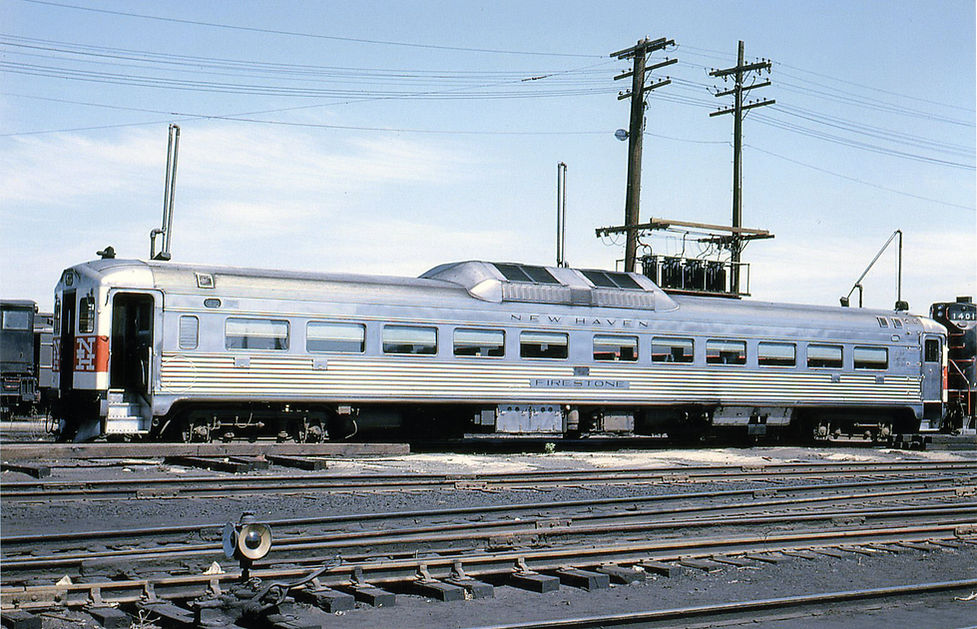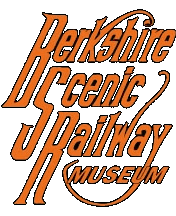New Haven 42
Built by the Budd Company,
Red Lion Plant, Philadelphia, Pennsylvania, March, 1953
Model: RDC-1, Phase-1b
Serial Number: 5720
Weight: 113,120 lbs

New Haven Railroad 42, "Firestone" is seen taking a curve underway sometime in the late 1950's.The Firestone nameplate can be seen in the center of the car under the number board. RDC 42 holds a significant place in the railroading legacy of the Berkshires. Photo from BSRM Collection.
The storied New York, New Haven & Hartford Railroad operated passenger trains in some of the country's busiest commuter territory - South Boston, Rhode Island, Connecticut and New York's Metropolitan Region. In addition, the New Haven operated intercity passenger trains that connected many smaller cities in New England with New York's Grand Central Terminal and Boston's South Station. As result of the dense passenger traffic, the New Haven's cost of operating such a large quantity of conventional passenger trains was burdensome, especially as the trifecta of the automobile, Eisenhower Interstate System, and the burgeoning airline industry eroded its passenger traffic. In 1950, the Budd Company offered the Rail Diesel Car (RDC) as a solution to the dilemma the New Haven faced. After the Boston & Maine, the New Haven owned the largest fleet of RDCs and was one of the first carriers to purchase the new, revolutionary rail car.
Able to operate with only a two-person crew - Conductor & Engineer - the RDC was designed with efficiency, flexibility and capacity in mind. Budd built the RDC in five versions:
-
RDC-1, 90-seat coach
-
RDC-2, 70-seat coach/baggage
-
RDC-3, 49-seat coach/baggage/Railway Post Office (RPO) compartment
-
RDC-4, baggage/RPO
-
RDC-9, a 94-seat coach designed as trailers only; they had no engineer control stations.
The RDC was flexible in that there were engineer controls at either end of the car for quick turnarounds at end terminals. The RDC was also capable of multiple unit operation (MU) - depending on demand, RDCs could operate alone or as a train with several RDCs coupled together but operated by one engineer. This design provided railroads with significant reductions in operational costs. In fact, the New Haven added passenger trains to various branch lines due to the low cost of operating the RDCs.
New Haven RDC-1 42 holds a unique place in railroad history as it is only one of two Budd RDCs ever specially named. Originally, NH RDC 26 was named "Firestone" after the Firestone tire plant in Fall River, MA which was one of the railroad's large freight customers. Sometime prior to 1956, the Firestone name plate was placed on number 42 after NH 26 was wrecked. By April 1970, 42 was owned by New Haven's successor, Penn Central (PC), and was repainted into PC's New York Central style RDC livery. At some point that year, the Firestone nameplate was removed from the car. 42 was transferred to the Massachusetts Bay Transportation Authority (MBTA) in 1976 and retired in 1989. On February 28, 1990 42 was sold to the Old Colony & Fall River Railroad Museum in Fall River, MA. It was delivered in March of that year, and over the ensuing years 42's interior and exterior was restored to its New Haven appearance - including the Firestone nameplate.
Car 42 also holds a significant place in the legacy of railroading in the Berkshires. Not only were RDCs used heavily in the Berkshires, 42 visited the Berkshire Line on several occasions, bringing passengers to the Berkshires from Danbury, CT and points south.
In 2017, the Old Colony & Fall River RR Museum transferred ownership of 42 to the BSRM. 42 safely made its way to our Lenox Yard in October of 2018 after $10,000 was invested to completely rebuild its air brake system prior to movement. BSRM has launched a fundraising campaign to help restore 42 to full, operational conditional. A generous $10,000 donation from CSX in late 2020 will allow for the replacement of all the windows on the car. In addition, new batteries were installed in August 2020, allowing electrical systems to be tested. BSRM Mechanical Department test fired the remaining Detroit Diesel and found it in overall good working order.


